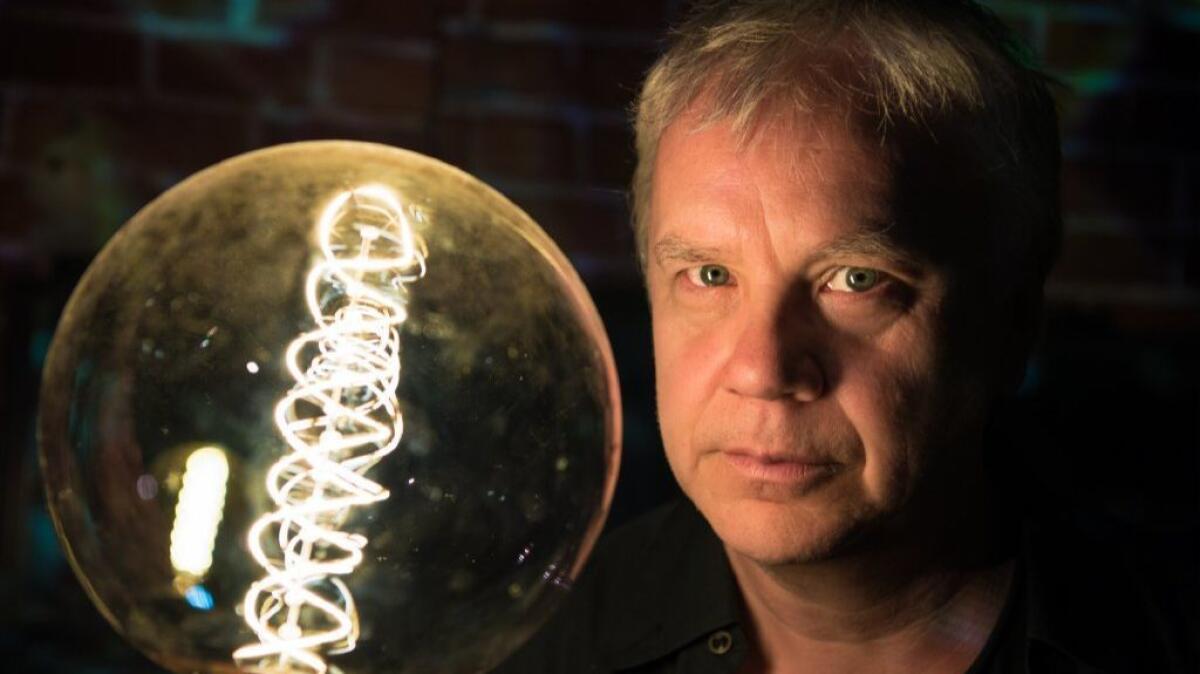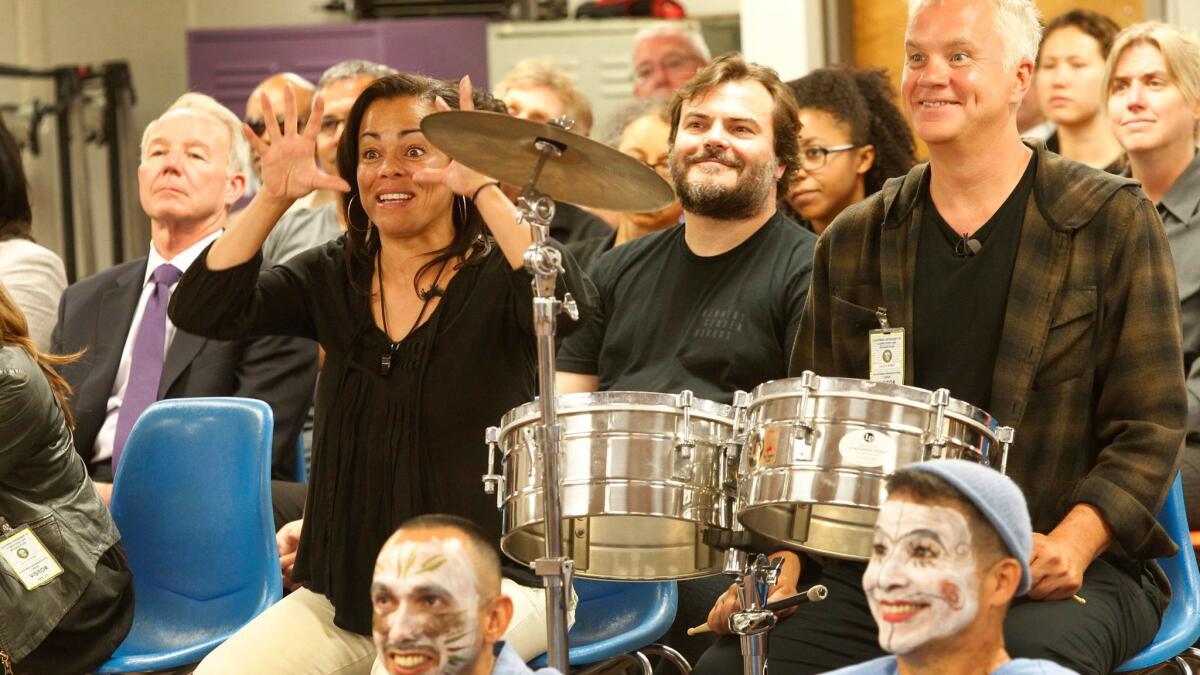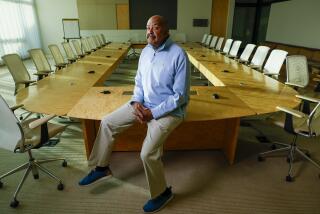L.A. without the NEA: Tim Robbins on his $50-a-week first acting job, and why it proves the power of the NEA

- Share via
Tim Robbins’ first time getting paid as an actor was through a grant from the National Endowment for the Arts. He was a gangly 15-year-old performing street theater in New York with Theater for the New City. His pay was $50 per week, and he could not believe his good luck.
“We were doing a social satire, exposing hypocrisy and corruption, and I remember thinking what a great country I live in that its government can support this theater company in its dissent,” Robbins said during a recent interview in the lobby of the Ivy Substation, which houses his theater company, the Actors’ Gang — itself a recipient of NEA funding for youth mentorship programs.
That $50 job lent legitimacy to Robbins’ developing career, so he kept at it for three summers. He figures that when all was said and done, the government invested about $600 in him through the NEA.
“Within 10 years the payoff to the government was millions of dollars,” Robbins said with a sly grin. “Seriously. By the time I was 10 years older, I was making the kind of money where my tax dollars were insane compared to what they had invested.”
Paying it forward did not begin and end with taxes for Robbins. In 1981 he became the founding artistic director of the Actors’ Gang, a theater company that has made community outreach, through educational programs in local schools and California prisons, its hallmark.
The idea that art or theater or music is some kind of luxury is misguided. For years the NEA has been creating economic engines throughout the country.
— Actors’ Gang co-founder Tim Robbins
The Actors’ Gang has received $138,000 from the NEA in the form of nine grants since 2003. Last year it received $25,000 to support its free Shakespeare in the Park, an annual summer affair tailored to attract families through popular-culture adaptations of the Bard’s famous works. Harry Potter “Hamlet,” for example, or Pokémon Go! “Romeo and Juliet.”
Of that $25,000, more than $17,000 went to pay artists and crews, nearly $3,000 covered other production expenses, $1,800 went to buy permits and licenses and an additional $3,000 went to union fees.
“It subversively gets kids into Shakespeare,” Robbins said. “Because the words are from the plays, it’s just that they’re being said by characters they identify with.”
Subversion through art is a thing with Robbins. He loves it. Art speaks truth to power, he says, and that’s why the NEA has had its funding cut and threatened so many times since it was created through an act of Congress in 1965.
“When there is a nationalistic or fascistic strain in government, why are the first people they target artists and intellectuals, writers of books?” he asks. “When you intimidate artists into silence, when you take away their funding, your dissent is reduced. Artists can bring audiences to a level of humanity and empathy that no politician can.… They can make the king look like a fool, and in doing that there is tremendous power.”
What those looking to cut funding for the NEA fail to realize, he says, is that the arts are actually powerful economic drivers in communities like Culver City. Robbins says the city was transformed by nurturing the arts since before the Actors’ Gang moved there from Hollywood in 2005, thanks to affordable rent made possible by the Culver City Redevelopment Agency.
“The idea that art or theater or music is some kind of luxury is misguided,” he said. “For years the NEA has been creating economic engines throughout the country. It has been transforming communities, and that’s just from a pure business standpoint.”
Culver City Mayor Jim Clarke points to the city’s 1.4-mile “Cultural Corridor” as a prime example of how a healthy investment in the arts can lead to large-scale revitalization. That corridor begins in the east with the Ivy Substation and the Actors’ Gang, calls Center Theatre Group’s Kirk Douglas Theatre the midpoint, and terminates in the west with Veterans Memorial Complex, the Wende Museum and United States Veterans’ Artists Alliance.
“It’s part of our own branding — what we’re trying to do in terms of being a center of cultural activity,” says Clarke, who shared a copy of a report the city commissioned from the Los Angeles County Economic Development Corp. titled “The Creative Economy of Culver City,” to be presented to the City Council next week.
The report’s executive summary says that in 2014, more than 8,500 workers were employed in Culver City’s creative industries, which include visual and performing arts, fine arts, entertainment, architecture, publishing and fashion. The resulting labor income amounted to nearly $1.1 billion.
“If 100 people come to the theater they will have something to eat. If a shop is there, they will spend their money,” Robbins says. “You’re talking about a depression of community when these arts organizations are forced to go away.”
The elimination of the NEA would not kill the Actors’ Gang, which has an annual operating budget of nearly $1.5 million. But it could kill other organizations, and it might kill important programs that his company engages in, Robbins said. This includes the company’s Prison Project Program and its Education Department.
The latter features classes that would, according to a grant the company applied for in 2003, increase arts accessibility for underserved urban audiences.
The Prison Project started in 2007 at the behest of Actors’ Gang member Sabra Williams. It doesn’t receive grant money directly from the NEA, but it has been given money by the California Arts Council, which received more than $1.1 million from the NEA in 2016.

The project, which aims to extend inmates’ horizons and emotional flexibility through improvisational theater, has expanded to 10 California prisons. According to the national research institute Impact Justice, participation in the Prison Project results in an 89% decrease in disciplinary incidents and a 50% reduction in recidivism.
In February, Robbins lobbied for arts in correctional facilities at a state Senate budget hearing in Sacramento. He told the politicians that if there were a drug made by a pharmaceutical company that could result in the kind of reduction in recidivism produced by the Prison Project, that they would be on the fast track to get it into every prison in the state.
“We have the drug and it’s the arts,” Robbins says. “But we don’t think of the arts that way. We don’t think of them as something that can save lives, that can shift perspectives and create transformations.”
In 1999 Robbins wrote and directed a historical drama called “Cradle Will Rock” about a New Deal program called Federal Theater Project, which provided government funding for artistic performances in the 1930s.
“The Roosevelt administration understood that recovery from the Depression wasn’t only about what we put in people’s pockets, it’s what we put into their souls,” Robbins says.
That idea should help to keep artists going in the face of the proposed elimination of the NEA, he says.
“I would encourage people to double-down, do more art, not less. Get in touch with why you started in the first place.”
“L.A. Without the NEA” is a series looking at a different community group, how its NEA funds were spent, what artistic or public good did or didn’t result and what the cultural landscape would look like if that program were to disappear. Look for past and future installments at latimes.com/LAwithouttheNEA.
ALSO:
The NEA works. Why does Trump want to destroy it?
Lin-Manuel Miranda’s ‘Hamilton,’ as vital as ever, opens in San Francisco
Robert Schenkkan’s ‘Building the Wall,’ set in Trump’s America
Spring preview: What to see in dance, theater, art, music
More to Read
The biggest entertainment stories
Get our big stories about Hollywood, film, television, music, arts, culture and more right in your inbox as soon as they publish.
You may occasionally receive promotional content from the Los Angeles Times.











